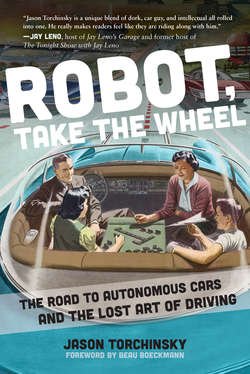Читать книгу Robot, Take the Wheel - Jason Torchinsky - Страница 20
На сайте Литреса книга снята с продажи.
1956: GM Firebird II Concept Car
ОглавлениеThe first time a major carmaker presented the idea of real autonomy to the public was in 1956, when GM showed their concept car, the Firebird II. As the name implies, this wasn’t the first Firebird concept car, but it was the first of the Firebird concept cars to suggest a then still-fictitious world of automated driving.
The Firebird concept cars were designed by Harley Earl and were heavily influenced by jet fighter designs. The Firebirds were showcases for cutting-edge technology, and as such employed exotic gas-turbine drivetrains, and cathode-ray tubes (CRTs—you know, the old big tube kind) in its television- and camera-based rearview systems.
More important for our purposes, though, is the automatic driving system that GM imagined for the car. This wasn’t just a concept for the car itself, but rather an entire network for automated vehicles, including specially prepared roadways with integrated “conductor strips” and control towers in the “Autoway Safety Zone,” the name given to the automated highway system in the film.
GM describes the system in a brochure published for the Firebird II’s introduction at GM’s Motorama show at the 1956 World’s Fair:
This amazing concept places control of the motorcar in the hands of an “electronic brain”—actually releasing the driver from the wheel. . . . These include a Dashboard View screen which has two panels. The left panel is for “internal communication” between car and driver (information he would normally receive from visible instruments as to fuel supply, engine operation and temperature). It also reveals a radar pattern when he guides the car onto the electronic control-strip for automatic steering. . . .
Extending from the two engine air scoops on each side of the nose of the car are probes or antennas which pick up wave impulses from the conductor strip in the center of the control lane.13
Of course, none of these things actually worked, but it is interesting to see how the very sticky problems of computer vision could be avoided if fully autonomous operation is limited to areas where an infrastructure has been built to guide the cars.
No mention is made of obstacle avoidance or anything like that; presumably, it is the job of the singing gentlemen in the control towers to make sure everything is running smoothly and to warn drivers to stop if they’re approaching a broken-down vehicle or a coyote on the road or something else they don’t want to barrel through. I’m not confident that would have worked out so hot.
Really, this sort of system is more like a hybrid of a tram or trolley car type of vehicle combined with a conventional car. On roads with the proper control towers and guidance strips, the car cedes control to the roadway network, much like a tram or train. On roads without the necessary hardware, you’re just driving a normal car, even if it is powered by a kerosene-fueled turbine and has a clear bubble dome.
Because of the very significant infrastructure investments required in such a system, nearly all modern self-driving technology and research is designed to work without outside, physical infrastructure help, which is, of course, a much more difficult task.
One more thing about the Firebird concept, and, specifically, the film GM made to promote it. The film shows a family on a road trip in their Firebird, enjoying all of the considerable comforts of 1950s-envisioned 1976 future life. At one point, based on the recommendation from the guy in the control tower who assures them that the “hostess is a dream,” they contact a nearby hotel on their dashboard video screen, where they see a lovely woman who sings the praises of the hotel.
At one point in the song she tells them about the restaurant at the hotel, and sings this line: “Our pre-digested food is cooked by infra-red!” I think it’s safe to say that what people are likely to find appealing has changed dramatically from what it was in the 1950s.
